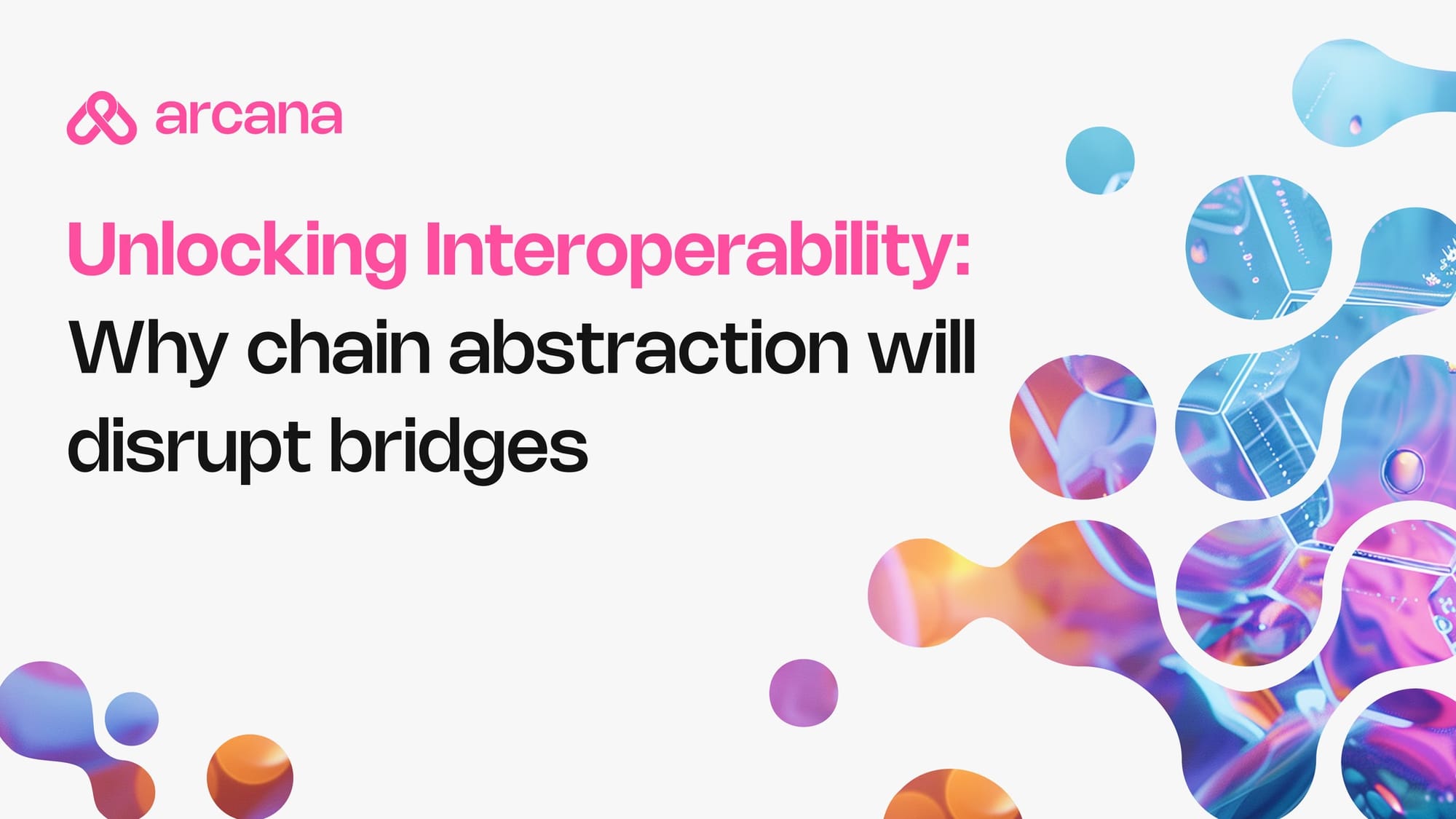Unlocking Interoperability: Chain Abstraction is Disrupting Bridges
Interoperability is a crucial factor for achieving seamless connectivity between different networks. Blockchain bridging, a solution designed to connect disparate blockchain ecosystems, has emerged as a fundamental component in this quest for interoperability.

Interoperability is a crucial factor for achieving seamless connectivity between different networks. Blockchain bridging, a solution designed to connect disparate blockchain ecosystems, has emerged as a fundamental component in this quest for interoperability. By allowing assets and data to move across various chains, bridges play a pivotal role in enhancing the utility and reach of blockchain applications.
However, despite their significance, traditional bridging solutions are not without their challenges. Security vulnerabilities, complex user experiences, and scalability issues have plagued the current bridging market, hindering its full potential. As the blockchain ecosystem grows, the need for more efficient and secure interoperability solutions becomes increasingly evident.
Understanding the Current Bridging Market
The bridging market is characterized by diverse solutions facilitating cross-chain transfers and interactions. These bridges are essential for interoperability between different blockchain networks, allowing users to move assets and data seamlessly across ecosystems. As the demand for decentralized finance (DeFi) and multi-chain applications continues to rise, the importance of robust and reliable bridging solutions has never been greater.
According to recent data, the total value locked (TVL) in cross-chain bridges has reached several billion dollars, reflecting these solutions' critical role in the blockchain ecosystem.
The top 5 leading players in the bridging market have a monthly transaction volume of over $1 billion. Here is the list of the top 5 bridges as per their 30-day transaction volume in the current market as per DefiLlama
Breaking down the pros and cons even further
- Circle CCTP
- Pros
- It was built by Circle, the issuer of USDC, ensuring seamless integration and stability for USDC transfers across chains.
- Circle’s strong regulatory stance ensures a compliant and secure transfer mechanism.
- Leveraging USDC’s widespread adoption provides high liquidity and lower slippage.
- Built-in security features and Circle’s established reputation reduce the risk of exploits and vulnerabilities.
- Cons
- Reliance on Circle’s infrastructure and regulatory framework can be seen as a centralization point.
- It was primarily focused on USDC, limiting the versatility compared to other bridges supporting multiple tokens.
- Any issues or changes in Circle’s policies or operations directly affect the protocol
- Pros
- Across
- Pros
- Focuses on providing fast and efficient cross-chain transfers.
- Aims to minimize transaction fees, making it cost-effective for users.
- Employs robust security measures to protect user funds and ensure safe transfers.
- Supports a variety of chains and tokens, enhancing its utility for different use cases
- Cons
- The system relies on relayers, which can introduce additional points of failure or trust issues.
- While efficient, scalability and network effects are still being tested as it gains adoption.
- It may face challenges in maintaining high liquidity
- Pros
- Orbiter Finance
- Pros
- Focuses on fast cross-chain transactions, minimizing the waiting time for users.
- Designed to be user-friendly with straightforward processes.
- Aims to offer lower transaction fees compared to traditional bridges.
- Employs robust security protocols to ensure safe transfers.
- Cons
- Limited chain support.
- Potential security concerns due to centralization.
- Still gaining traction in the market, which might affect liquidity and network effects
- Pros
- StarGate Finance
- Pros
- Solve the bridging trilemma with unified liquidity.
- Instant guaranteed finality
- Cons
- Complexity of the Delta algorithm.
- Potential liquidity exhaustion risk
- Pros
- Arbitrum Bridge
- Pros
- Utilizes optimistic rollups to achieve high throughput and low transaction costs.
- Benefits from Ethereum’s security as it operates as a layer 2 solution.
- It is designed to handle many transactions efficiently, making it suitable for high-demand applications.
- Strong integration with the Ethereum ecosystem, allowing easy access to a wide range of dApps and DeFi services
- Cons
- Due to the challenge period in optimistic rollups, withdrawal from layer 2 to layer 1 can take up to a week.
- Initially, there are centralization aspects in the validation process, though the team is working on decentralizing further.
- Users need to understand layer 2 mechanics and bridging processes, which might be complex for newcomers.
- Although lower than Ethereum mainnet, gas fees can still be significant during network congestion
- Pros
Why Bridging isn’t the best for end users? The risks?
While blockchain bridges play a critical role in enabling cross-chain interoperability, they are not without their significant drawbacks. The following are some of the major disadvantages associated with traditional bridging solutions:
- Fragmentation of Funds: One of the primary challenges with traditional blockchain bridges is the fragmentation of funds. When users transfer assets across different chains, the original assets are often locked in a smart contract on the source chain, while equivalent tokens are minted on the destination chain. This process leads to liquidity fragmentation, as funds are split across multiple chains and wrapped versions of assets. This fragmentation can create inefficiencies in liquidity management, making it more difficult for users to access and utilize their funds seamlessly.
- Slow Transaction Speeds: Another major drawback of traditional bridges is the slow transaction speeds. Cross-chain transfers typically involve multiple steps, including locking, minting, verifying, and finalizing transactions on different networks. Each step can introduce delays, especially if the networks involved have different consensus mechanisms and processing times. As a result, users often need more time to complete their transactions, which can be frustrating and hinder the overall user experience.
- Security Risks: Security is a paramount concern in the blockchain world, and traditional bridges are no exception. The complexity of cross-chain transactions and the reliance on smart contracts to lock and mint assets introduce multiple attack vectors. Hackers can exploit smart contracts, consensus mechanisms, or bridge infrastructure vulnerabilities, leading to substantial losses. High-profile bridge hacks, such as the Poly Network and Wormhole incidents, have underscored the inherent risks and the need for more secure bridging solutions.
Security is one of the major concerns around Bridges. According to ChainAnalysis, bridges accounted for 70% of stolen funds in 2022. - Complex User Interface for Non-Native Users: Traditional bridges' user interfaces are often complex and challenging for non-native users. Transferring assets across chains typically requires users to navigate multiple steps, including selecting the correct chains, verifying transaction details, and managing multiple wallets. For users unfamiliar with blockchain technology's technical intricacies, this complexity can be overwhelming and deter them from using cross-chain solutions. Simplifying the user experience is crucial for broader adoption and usability.
These disadvantages highlight the limitations and inefficiencies of traditional bridging solutions. As the blockchain ecosystem continues to evolve, there is a growing need for more advanced and user-friendly approaches to cross-chain interoperability. Intent-based chain abstraction presents a promising solution to address these challenges, offering a more secure, efficient, and accessible way to connect disparate blockchain networks.
Enter chain abstraction, a revolutionary approach poised to transform how we think about cross-chain interactions. By shifting the focus from manual, push-based transaction processes to an intent-driven pull-based approach, chain abstraction promises to address the shortcomings of traditional bridges and pave the way for a more interconnected blockchain future. In this blog, we will delve into the current state of the bridging market, examine its limitations, and explore how chain abstraction can disrupt and redefine this critical aspect of blockchain technology.
Conclusion
While essential for cross-chain interoperability, the current state of blockchain bridging needs to be improved with significant drawbacks. These challenges hinder the efficiency of cross-chain transactions and limit the accessibility and adoption of blockchain technology, especially among non-native and non-technical users.
In summary, chain abstraction offers a revolutionary approach to addressing these issues by simplifying the user journey and enhancing the overall experience. By focusing on intent-based operations, chain abstraction eliminates the need for users to manage and navigate the complexities of cross-chain transfers manually.
About Arcana Network
Arcana Network is building a modular L1 to power Chain Abstraction and intents, helping developers significantly improve user experience in Web3. Since 2021, we've introduced three groundbreaking products.
First up is Auth SDK, a decentralized social login to generate non-custodial Wallets. It is the fastest social login in web3, with a sub-3-second login time, and is free of cost. Games and consumer apps widely use auth SDK to simplify web3 user onboarding. Get a secure, in-app wallet, instantly, with no passwords or installations needed.
Next, Arcana Gasless is based on ERC-4337 Account Abstraction and enables developers to sponsor gas fees for users.
Our third product, SendIt, is a consumer app that redefines crypto payments by allowing users to send crypto to an email address, making transactions effortless and inclusive. SendIt has partnered with BNB and OKX.
Arcana has raised $4.5M from 40+ leading investors including Balaji S, Founders of Polygon, John Lilic, Santiago Roel, and funds like Woodstock, Republic, Fenbushi, Polygon ventures, DCG, and others.
Discover the Power of Chain Abstraction
Want to dive deeper into how chain abstraction can simplify your blockchain projects? Visit our Abstracted Academy and unlock the potential of seamless interoperability across chains.
Official Links: Website | Telegram | Twitter | GitHub | Discord

